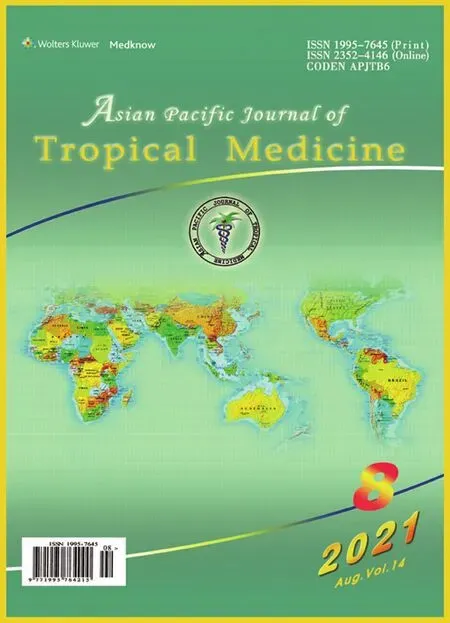Failure of space spraying to eliminate dengue virus-infected Aedes aegypti may explain failure to prevent secondary cases in Southern Thailand
Kemmapon Chumchuen, Theerakamol Pengsakul, Edward B McNeil, Natthaphon Nanakorn, Virasakdi Chongsuvivatwong
1Epidemiology Unit, Faculty of Medicine, Prince of Songkla University, Songkhla, Thailand
2Faculty of Medical Technology, Prince of Songkla University, Songkhla, Thailand
Dengue is a febrile disease caused by a member of the Flaviviridae family called dengue virus (DENV). DENV is primarily transmitted to humans by blood ingestion of Aedes (Ae.) aegypti[1,2]. Space spraying is a vector control measure recommended by the World Health Organization (WHO) for eliminating vector mosquitos and preventing further infections in an epidemic setting[3].Evidence of the effectiveness of space spraying in reducing vector mosquito populations and risk of contracting DENV is limited and inconclusive[4]. This study aimed to implement dengue virologic surveillance for assessing the effectiveness of space spraying in eliminating infected female Ae. aegypti over the course of spraying.
This study was approved by the Institutional Ethics Committee of the Faculty of Medicine (registration number: REC. 62-200-18-1) and the Animal Ethics Committee of the Faculty of Science(registration number: 2562-10-035), Prince of Songkla University,Thailand.
Adult Ae. aegypti samples were collected from households located within the targeted communities for space spraying in response to dengue cases in endemic areas in Songkhla, Thailand. The selected households consisted of index case households and surrounding households within the spraying area. Mosquito collection was conducted 5 times in each household (before, day of spraying, and 2, 4 and 6 days after spraying). Collected Ae. aegypti from each household on each collection day were placed into pools of 1 to 5 Ae. aegypti of the same sex for detection processes. RNA was extracted from the pooled samples, and were tested for DENV using a one-step real-time reverse transcription-polymerase chain reaction(RT-PCR).
The main outcome variable is the number of infected Ae. aegypti pooled samples. We used stratified jitter plots to identify the changes, characteristics, and distributional pattern of Ae. aegypti pooled samples over the course of spraying. Fisher’s exact test or Chi-squared test was used to assess significant differences between/among proportions, where appropriate. The level of significance in this study was set at P<0.05.
The distribution and characteristics of female and male Ae. aegypti pooled samples in 18 study houses are illustrated in Figure 1. Eight of 18 sampled households (44.44%), including one index case household, had at least 1 pool that consisted of at least 1 infected female Ae. aegypti from day 1 to day 7 after spraying. For male pools, the respective number was 9 of 18 households (50.00%).Table 1 summarizes the number of Ae. aegypti pooled samples and DENV prevalence by sex and serotype. The prevalence of DENV-2(9.69%) was higher than DENV-3 (1.18%). The association between the 2 sexes and 3 serotypes was tested using Fisher’s exact test. The P value was 0.424 indicating no evidence of an association between the sexes of Ae. aegypti and serotypes. Furthermore, the number of infected pooled samples in 5 collection days were 14, 4, 6, 10 and 12, while the total pooled samples were 90, 32, 80, 70 and 105. The was no association between the DENV prevalence and collection day, Chi-squared P value was 0.675.
This study showed that the circulation of DENV still remained after the implementation of space spraying as nearly half of the sample households contained at least 1 pool of active female Ae. aegypti with at least 1 positive DENV infection. In addition, half of the households contained at least 1 pool of male Ae. aegypti with at least 1 positive DENV infection which was unexpected, as male Ae. aegypti does not feed on human blood. Although males do not contribute to the direct transmission of DENV, this finding indicates possible transovarial or venereal transmission of the disease[5-8],which requires further investigation in order to determine the the underlying mechanism, and together with persistent presence of infected Ae. aegypti, these factors may be a contributing cause of secondary dengue cases after space spraying.


Table 1. DENV prevalence in Aedes aegypti pooled samples stratified by sex [n (%)].
Conflict of interest statement
The authors declare there is no conflict of interest.
Acknowledgements We thank the following people for their contribution to this paper.Mrs. Sarintip Muneesawang and staff from the Local Administrative Office for their cooperation and assistance; the locals of Bo Yang sub-district for allowing us to conduct this study; and the Faculty of Medical Technology for allowing us to use their laboratory.
Funding
This study was supported by the Program Management Unit for Human Resources & Institutional Development, Research and Innovation-CU (grant number B16F630071) and TSRI Fund (CU_FRB640001_01_30_1).Authors’ contributions
K.C., T.P. and V.C. conceptualized the study. K.C., T.P. and N.N.performed data collection. Both K.C. and E.B.M. performed data entry and analysis. K.C. prepared the original draft of the manuscript.T.P., V.C., E.B.M. and N.N. reviewed and edited the manuscript.All authors contributed to the final version of the manuscript. V.C.supervised the project.
 Asian Pacific Journal of Tropical Medicine2021年8期
Asian Pacific Journal of Tropical Medicine2021年8期
- Asian Pacific Journal of Tropical Medicine的其它文章
- Prevalence and clinical significance of antiphospholipid antibodies among hospitalized COVID-19 patients
- Predictors of in-hospital mortality by logistic regression analysis among melioidosis patients in Northern Malaysia: A retrospective study
- EWMA control chart based on its first hitting time and coronavirus alert levels for monitoring symmetric COVID-19 cases
- Co-expression of HBZ, TAX and FOXp3 and HTLV-1-associated myelopathy/tropical spastic paraparesis development in HTLV-1-infected individuals: A systematic review
- Determinants of COVID-19 vaccine acceptance and encountered side-effects among the vaccinated in Bangladesh
